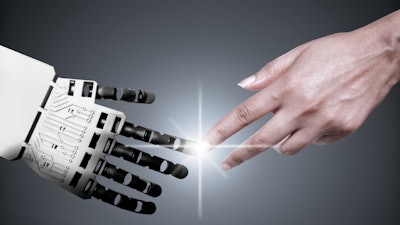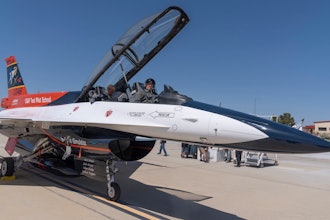
The world has changed, and the cliche that all companies are tech companies is quickly becoming an undeniable reality. For example, did you know that major power companies are now using drones and AI-powered video to inspect pipelines and high-tension power lines? Even legacy industrial equipment companies are getting in on the AI revolution—John Deere has implemented technology to allow their equipment to deliver appropriate water and fertilizer on a plant-by-plant basis, without human interaction.
The facts are clear: emergent technology has permanently changed the way we do business. Leading companies are harnessing technology and software to make significant improvements on their products and the outcomes they produce. As a result, these companies are building stronger long-term relationships with their customers, experiencing the benefits of ‘stickier’ products.
It’s irrefutable that AI has complicated things. AI’s rise has already caused major impacts throughout this industry, and companies that don’t embrace this new technology will find themselves at a significant disadvantage in the near future.
How Manufacturers Will Keep Up
First, it’s critical to understand that the automation delivered by AI will inevitably impact headcount in technology-driven companies. Our researchers estimate that operationalizing AI could result in a roughly 20 percent reduction in headcount.
In this current economic climate, thanks in large part to high interest rates and decreasing tech investments, profitability has become crucial for companies to survive. That’s where AI comes in.
Consider Microsoft as an example. in 2024, the company sported a global workforce of 221,000 employees. According to Payscale, the average annual salary and bonus for Microsoft employees is $140,000. Additionally, Care.com reports that benefits typically amount to an additional 30 percent of a Microsoft employee's annual compensation. This means that Microsoft is spending approximately $182,000 per employee per year. Globally, this translates to $40 billion annually, accounting for nearly 40 percent of the company's total revenue. So even a seemingly marginal one percent reduction in labor costs would result in a substantial $400 million increase in Microsoft's bottom line.
Now, when you apply that same logic to the ramp-up of new technology in the industrial equipment space, the benefits will be similar, but the delivery is markedly different. Many industrial equipment businesses don’t have a mature tech staffing structure in place, so the overall headcount cuts will be smaller. However, AI will speed up the creation and delivery of new offerings and services, while improving efficiencies throughout the business.
Walking the Walk
Although the financial benefits of implementing AI capabilities are abundant, the effective deployment of AI still remains a complex and uncertain endeavor for many organizations. Management teams pursuing an AI-native stance need to actively navigate several core concerns, including:
- What AI use cases will have the greatest financial impact on our business?
- What factors prevent companies from successfully deploying new AI capabilities?
- How long before AI capabilities significantly reduce headcount requirements in our industry?
These three questions define what we’re calling the black box of operationalizing AI.
Modern businesses pursuing AI deployment need to address these critical questions as they strive to implement well-timed and balanced operational changes to minimize missteps. Setting the groundwork for addressing the operationalization of AI is no easy task, after all—several factors require thorough evaluation and adjustment from the outset.
The foremost, and perhaps most significant factor, concerns the centralization, accessibility, and cleanliness of the company's large datasets. This data serves as the foundation upon which AI capabilities will be built.
Accordingly, every company needs to have telemetry in place to gather data from its products and services. Without it, they're setting themselves up for failure—no two ways about it. After all, data feeds AI and ultimately powers its ability to deliver seamless automation. And as AI continues to automate both internal and product functions, it will also bring about increased speed and efficiency, setting new professional expectations globally. Competitive companies must be at the forefront of these changes.
Put another way? Companies with siloed data will struggle to succeed in implementing AI. Segmented data will create myriad challenges for AI technology to use—but it isn’t all doom and gloom. Organizations are still well within their abilities to adjust and eliminate those pesky data silos, thereby creating an AI-friendly structure. Similarly, companies without robust data sets will inevitably find themselves falling behind the competition, as they simply won’t have the resource to fuel their AI engine.
Moreover, the implementation of AI will necessitate a concerted internal concentration on change management. The rationale? Although AI can easily automate tasks that are typically human-performed, it has limitations and requires people to work with the technology. Make no mistake, implementing change in business is tough work—two-thirds of all change initiatives fail. That fact alone makes creating a solid foundation to drive AI changes at all levels of the business imperative, and that initiative begins with leadership.
Every tech company pursuing AI implementation needs to have a senior leader responsible for driving these changes. But the company also needs clearly-delineated goals related to AI success, with employees incentivized to move these changes forward. Few will embrace changes like these if they believe the tool is simply being established to replace them. That makes it essential for leadership to help employees understand that the future is one where humans and AI are working in concert.
As AI continues to transform the modern business world, industrial equipment companies find themselves in a unique position: How can they continue to ramp up their tech offerings while adopting and deploying AI in their models? Navigating these times isn’t going to be easy, but the benefits are immeasurable. Any company that hasn’t started down this path is already behind the wave—and needs to move quickly to keep up in the coming years.
George Humphrey is a Distinguished VP & Managing Director at TSIA.






















